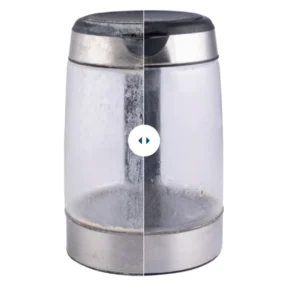
How to Remove Limescale from your Kettle
22 March 2024
View PostPosted on 13 September 2022 9 min read
Cleaning glass can be a really tedious job. Whether it’s your windows, your oven door, your shower screen or even decorative items, glass has a habit of attracting dust, limescale and dirt incredibly quickly.
And if you don’t get your cleaning method spot on, glass can be left streaky and even worse – scratched. In this helpful guide from the Harvey Water Softener experts, we look at how to clean the most common glass areas in the home, – as well as how you can banish troublesome limescale for good!
If you’re looking for more home cleaning tips, head on over to our blog for helpful cleaning guides on a range of different topics.
Whether you have a window cleaner or do the job yourself, the likelihood is that you need to clean your windows yourself at some point or another. Over time, windowpanes build up with dirt and grime, both inside and out. By cleaning off corrosive contaminants, you can also increase the longevity of your windows, so it’s important to keep them looking clean and tidy.
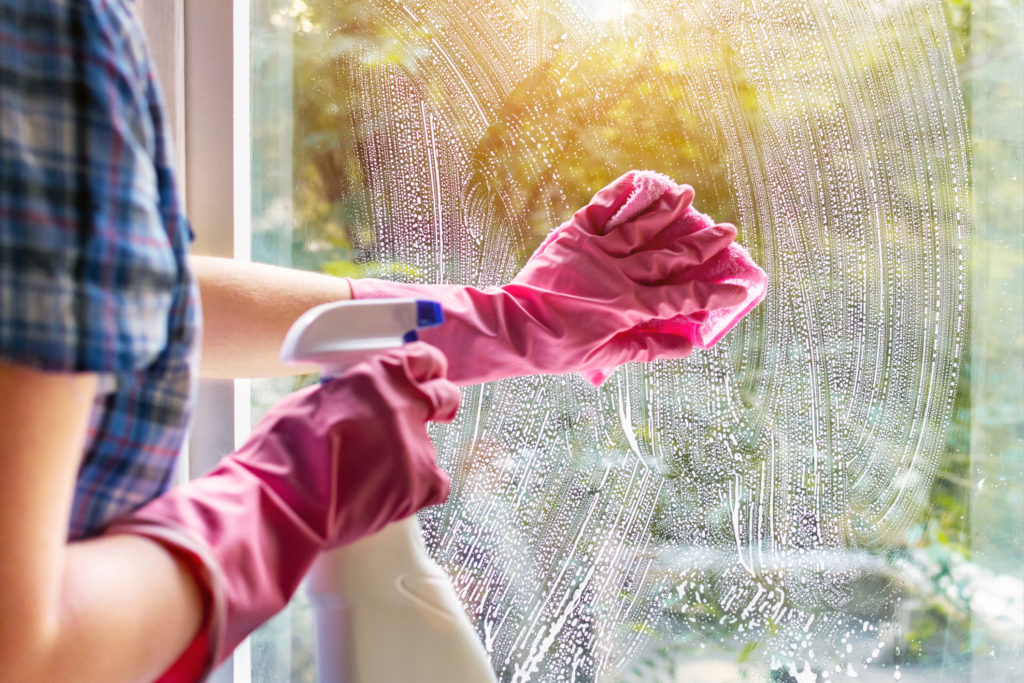
Hard water stains and limescale can be removed from your windows relatively easily, depending on how long they have been left. There are lots of chemical cleaners available from supermarkets, DIY stores and home stores that will remove hard water stains quickly and efficiently.
However, if hard water stains have been left to sit for a long period of time, you’ll find that they require more elbow grease to remove. Investing in a water softener could be a more permanent solution. A water softener is purpose-designed to remove calcium and magnesium from your water supply, the two minerals that contribute to hard water. Essentially, this removes the minerals that cause limescale, banishing it from your home for good.
If you live in a hard water area, the effects of hard water on windows are incredibly pronounced as you will be using your hard tap water to clean the glass in and around your home. You may notice water marks appearing on your windows, even if you have cleaned them really well.
In the UK, hard water is defined as water that has more than 200 parts per million of calcium and magnesium in it. It’s estimated that over 13 million homes in the UK suffer from hard water, with the worst places being Ipswich in Suffolk and Hull in East Yorkshire.
You’ve spent hours cleaning your windows and you’re now left with streaky glass. Thankfully, there is a way you can achieve a streak-free finish that will impress your guests and all you need is vinegar and hot water.
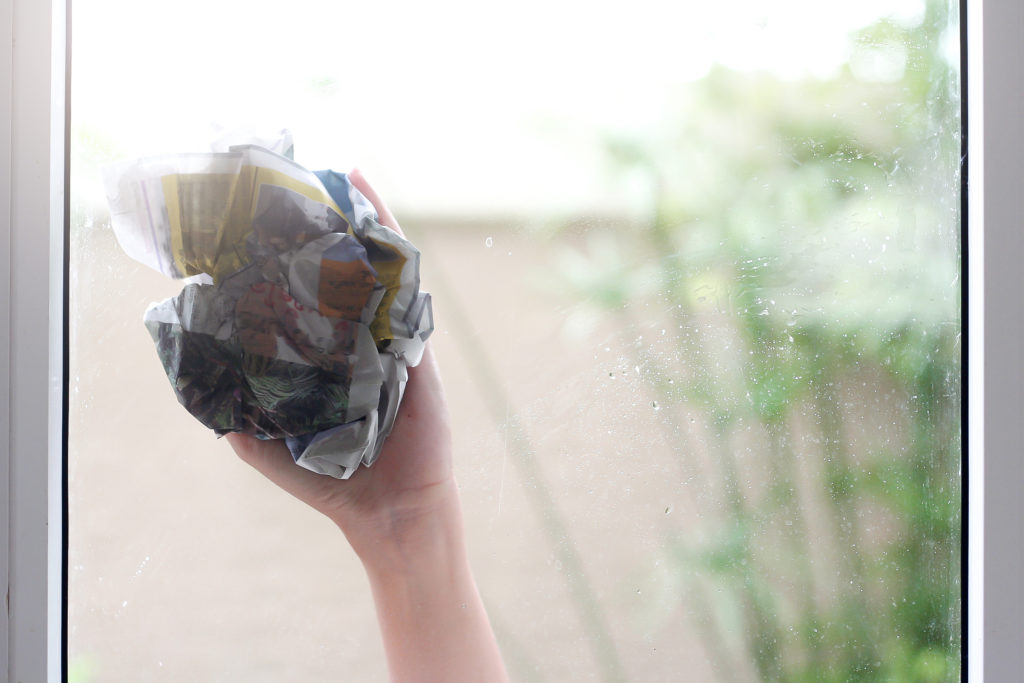
Limescale impacts hot areas of the home more than cold, so it makes sense that if you live in a hard water area, your glass shower screen could see the brunt of any limescale build-up.
Thankfully, you can spray your screen liberally with a limescale reducing product and give it a good wipe down. Naturally, this is something that needs to be done more often the harder your water is. A water softener is a more permanent solution as it completely removes the limescale-causing minerals that naturally occur in your water.
For more information on keeping your shower sparkling, check out our in-depth guide on shower cleaning tips.
With their smaller surface area and generally harder- to- reach nature, car windows can be a nightmare to clean, both inside and out. Follow our top tips below to keep them sparkling clean without the need to hire pricey detailers or take your pride and joy to the local car wash.
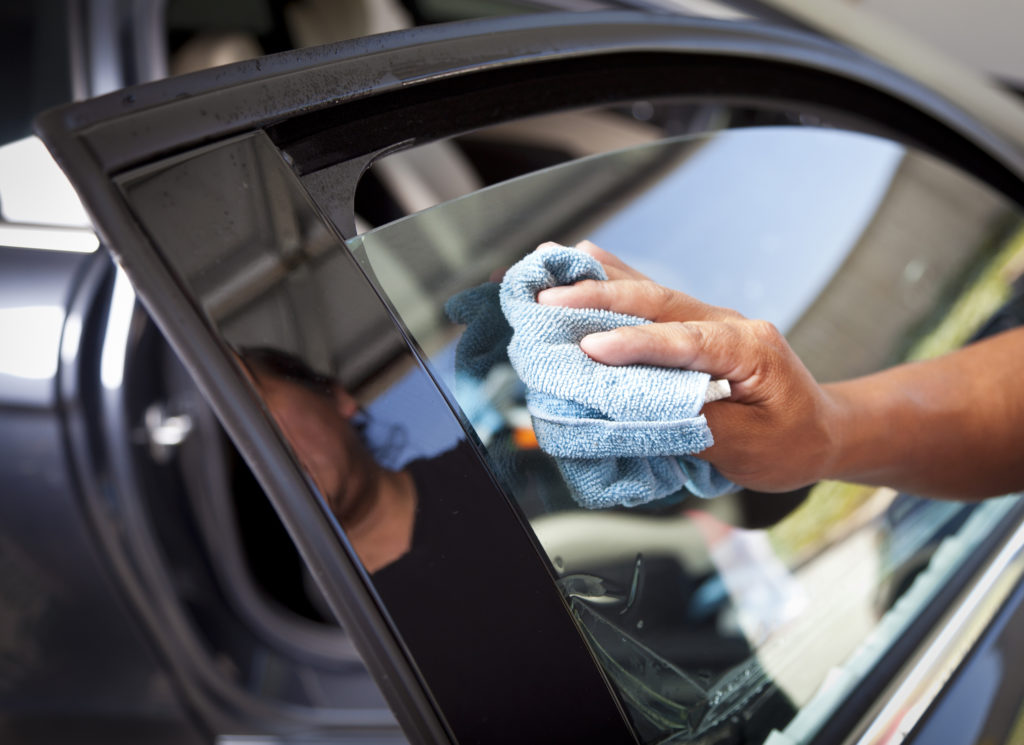
Mirrors are a great way to create a feeling of spaciousness and airiness in a room, but keeping them sparkling can be very difficult, especially if you live in a hard water area. Increasing the lifetime of your mirrors is also better for the environment since they take a very long time to degrade and decompose. Follow our top tips below to keep them looking great.
You can use kitchen towels to clean your mirrors, but these are likely to leave lint as you wipe. It’s quicker and easier to use a microfibre cloth as these won’t leave any residue or fibres on your mirror – reducing that sparkle.
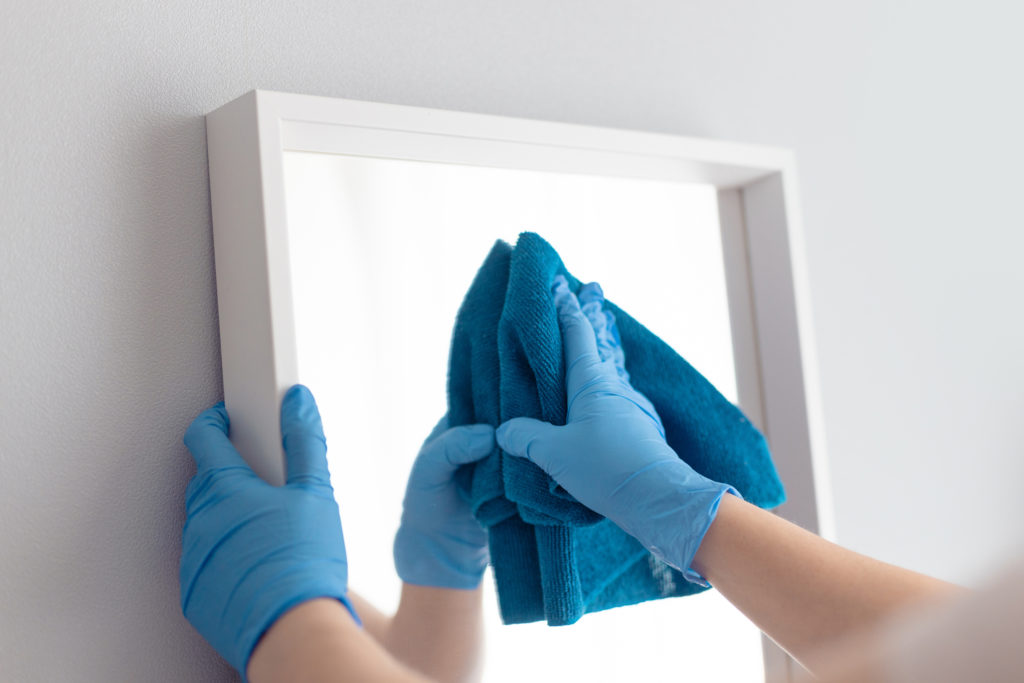
Often forgotten but crucial to keeping your mirror in pristine condition, the edges of the mirror will need to be cleaned too. Once you’ve finished cleaning the main sections of your mirror, take something like a cotton bud and wipe around the edges. This is much easier than trying to get your cloth into those tight corners.
Whether you are using a homemade glass cleaner or branded product, it’s important to apply it straight to your cloth, rather than the glass itself. Not only does doing this make the mirror easier to clean, but spraying the solution directly onto the surface could seep underneath and cause damage over time. This is also known as ‘mirror rot’ which causes black edges.
If your mirror is in a high traffic area, like a bathroom or hallway, you may find that it picks up dirt and grime like fingerprints or toothpaste splatters much quicker than one which rarely sees any use. Therefore, spot cleaning in between full cleans is the best course of action.
Take a cotton bud and be precise in the area you’re targeting. If you have any rubbing alcohol, you can dip your bud into the solution and rub onto the affected area until the mark disappears.
Glass is a luxury item that looks great in any home – especially in the kitchen or dining room. If you’re looking for glass dining table cleaning tips, then you’ve come to the right place.
It doesn’t take long for dust and dirt to settle on flat glass surfaces, so starting off with a gentle wipe of the surface will get your glass tabletop primed and ready for a deep clean. A clean and dry tea towel will work well to remove any surface dirt.
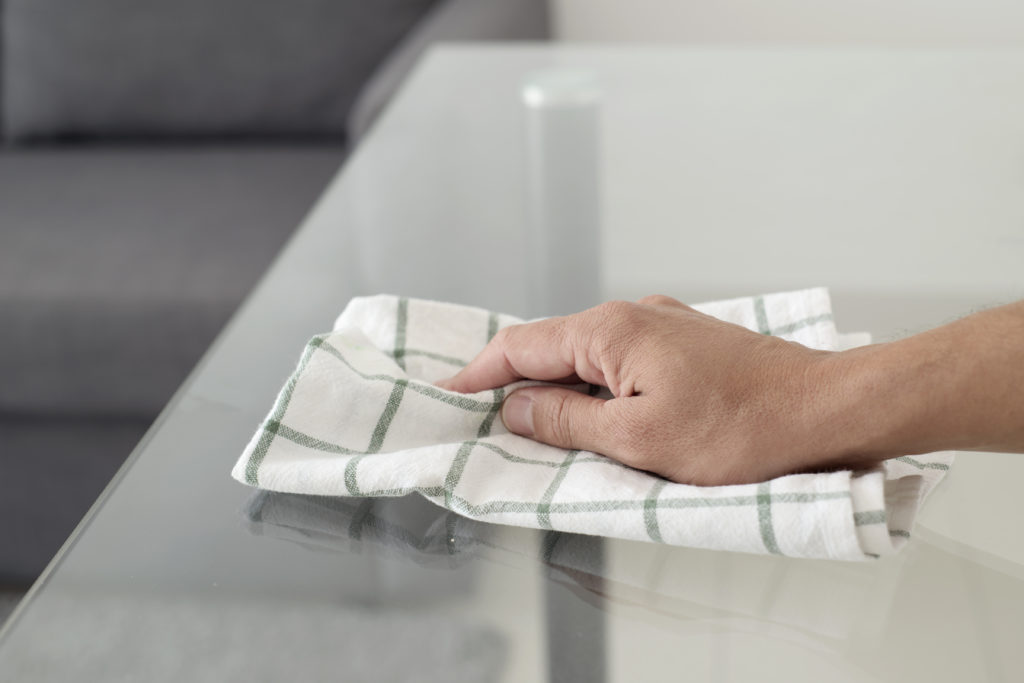
Microfibre cloths are fantastic to buff and clean glass, but it’s incredibly important that they are clean. Even the slightest amount of grit or dirt held within the cloth could cause devastating damage to a glass tabletop in the way of scratches.
Spray your cleaning solution onto your microfibre cloth, but make sure you’re using it sparingly. Overloading your cloth with cleaning products will leave your glass looking hazy as the excess residue dries.
Reaching incredibly high temperatures, your oven endures a lot of impact over the years, with the glass door in particular gathering hardened food over the course of its lifetime. The best thing to do here is to tackle the build-up regularly – the higher temperatures that oven doors and hardened food is subjected to, the more difficult it will be to shift.
Read on below for our top tips on how to clean your glass oven door.
The outside of your oven door is the easiest – that’s because there shouldn’t be any hardened food lingering on the surface of the glass, just a couple of fingerprints you might want to get rid of.
Cleaning the inside of your oven door is harder work. This is because all the hardened food and grease will have been sitting there since the last time you cleaned it – getting harder to remove with every use with each use of your oven.
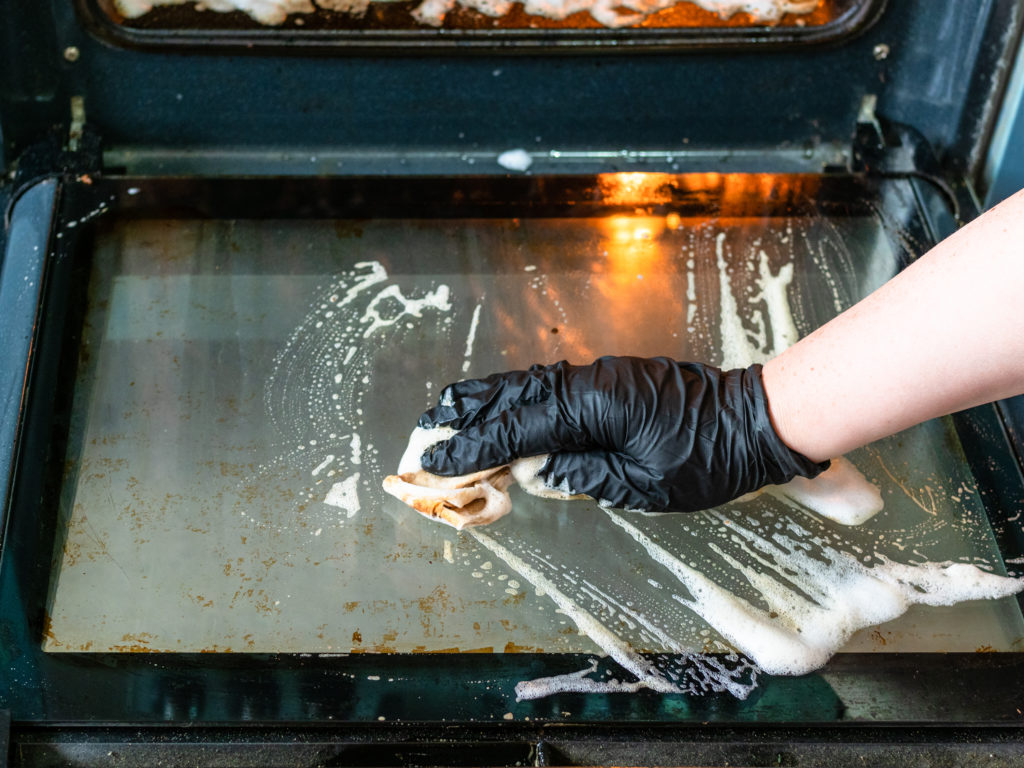
To clean the inside of your oven door, follow the steps below:
And there you have it, our top glass cleaning tips to keep your home looking cleaner for longer. For more helpful tips, check out our guide on ‘Reducing Limescale in Your Kettle‘